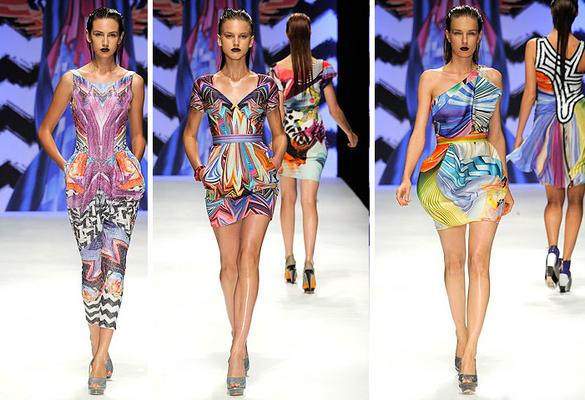Behind Fashion's Burst of Intricate Patterns Is a New Kind of Printing
By : Christina Binkley
Presenting high fashion—now brought to you by inkjet printer.
The stores and runways this spring are full of clothes with intricate prints—not just flowers but unique, often enigmatic designs resembling artwork. Behind this profusion of patterns is a familiar piece of technology: a printer not unlike the one sitting on your desk.
High-end design's embrace of this technology is adding a new dimension to couture. Designers for brands like Helmut Lang, Akris, Zac Posen and Valentino can create custom fabrics more easily.
A series of dresses and tops in the current Helmut Lang collection uses photographs shot by the brand's designers, Nicole and Michael Colovos, some of them with an iPhone. The designers shoot photos of peeling paint, subway walls and other sights that inspire them, and then scan the pictures into a computer, creating collages that may look nothing like the individual photos. One dress print based on a collage looks like X-rays of vertebrae. Another seems to be pebbles in a stream.
New prints like these are not the sort of repetitive patterns we're accustomed to—stripes, dots or flowers repeated across the fabric. They're abstractions, and they make you stand back, then look close, the way you would in a museum.
For top designers, printing images directly onto fabric is a big shift. Until recently, textile patterns that weren't woven into fabric were commonly made with screen printing. In that more costly and labor-intensive process, mesh screens must be engraved by skilled artisans with the designs that will be printed. Dyes are then squeegeed through the screens onto fabric one color at a time. A single order can take days or weeks.
Digital printing—which lays down a whole image on fabric, as on paper—has been used for years to put photographs on T-shirts and shopper bags. But there have long been quality problems—the inks tended to run, and edges printed fuzzily.
Gradually, however, inks and printers improved to create more enduring, crisper-looking prints. Digital printing is often cheaper than screen printing—and it's faster, in an age when speed to market is everything.
On Akris's runway in Paris in March, designer Albert Kriemler used a photograph of a mountain's reflection in a still glassy lake. The original photograph came from a newspaper, but Mr. Kriemler turned it sideways and altered the colors, creating something so different that one viewer swore was the Shroud of Turin. "I wanted to be mysterious," says the Swiss designer.
In another case, Mr. Kriemler made a dress fabric from part of a painting by the late artist Ian Hamilton Finlay, a friend of his. Where necessary, he says, his office obtains copyright permission.
The new technique has emerged on the runways in force in the past year or two. It comes just as fashion could use a shot in the arm. Recently, designers have plumbed and replumbed the most common silhouettes for clothing. We've gone from floor-length dresses to minis. Menswear has been skinny and broad. Futurists like Rei Kawakubo and Yohji Yamamoto have experimented with lumps, bumps, holes and asymmetrical looks.
Textiles—new weaves, new materials and new prints—offer rich creative possibilities. Digital prints, says Helmut Lang's Ms. Colovos, are "a new breakthrough." When I saw the Helmut Lang prints in the showroom, I felt compelled to grab the fabric to get a closer look.
Yet with anything new, something old suffers. For decades, screen printing has supported legions of artists. Michele (pronounced Micaylay) Binda and his family now have four digital printers at their plant in Como, Italy, where for three generations, they have produced fabrics for fashion houses such as Pucci, Versace, and Oscar de la Renta. But he views the digital method as a mixed blessing.
On the one hand, his new machines and skills are helping him compete with textile producers in China. Because less manual labor is required in digital printing, low-labor-cost nations like China have less of a cost advantage. But, he says, "these machines are in a way killing the old screen printing technique."
Not all designers embrace digital prints. They don't attain the deep, clear hues of screen prints because the ink doesn't soak into the fabric as thoroughly. And designers need technicians who understand the software. It used to be that a great print designer "needed to have a great hand," says Akris's Mr. Kriemler. "Now you have to have a great hand with the computer."
"I want the hand of the artist," says designer Catherine Malandrino. She employs two artists in New York to draw and paint her prints, which are screen-printed in layers of as many as 12 colors. "I think I will never go to digital." But the technology is improving season by season. Designer Sara Rotman recently moved production of her silk Loquita label scarves from screen-printing in China to digital printing in Italy. She says the quality improvements in Italy's digital printing are "blowing my mind in a beautiful way." Now, she says, "I'm getting crisp, sharp edges that I can't get in screen print."
Digital technology allowed Theia designer Don O'Neill to get a job he would otherwise have lost. He was given three weeks to create a pastel floral print gown for singer Carrie Underwood's appearance at the Academy of Country Music Awards in Las Vegas last month. The designer grabbed a painting of red poppies that he'd purchased from a Milan print producer years ago and shipped it to Mr. Binda in Como. (He had previously purchased the rights to use it as a print.)
Mr. Binda scanned it, enhanced the colors, and shipped back yards of silk organza imprinted with the poppies. Ms. Underwood had her dress—custom fabric and all—within what would have otherwise been an impossible deadline. "Digital printing," says Mr. O'Neill, "is awesome."
